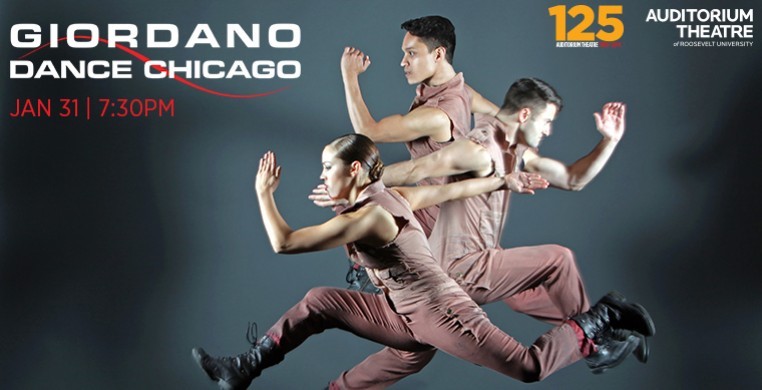Giordano Dance Chicago’s dazzling performance drew whoops and cheers from a packed house in its first ever full-length engagement at the Auditorium Theatre Saturday night as part of the Auditorium’s “Made In Chicago” series.
The company, always high-octane and impeccably polished, knocked it out of the park for this concert, expanding range of movement and expression to fill the grand Auditorium stage at a new and impressive level of artistry and style. The dancers gave their all to each other and to their audience with uniformly virtuosic technique and an abundance of spirit again and again in each of the five works in the concert.
Programming for this venue was especially conducive to observing GDC’s evolution as a jazz dance company, which began 52 years ago under its founding director, Gus Giordano. Gus, always one for innovation, would have been proud. Today, propelled forward by a new and expanding definition of jazz dance in America, the inspired team of Artistic Director Nan Giordano, Assistant Artistic Director Homer Hans Bryant, and Executive Director Michael McStraw is truly building a unique identity that sets this company apart from the many excellent contemporary dance companies whose repertories cross genre boundaries. There are several reasons for this--astute choice of repertory and music, active, ongoing professional training, keen attention to ensemble development, and artistic leadership that is both exacting and nurturing, all of which affect the dancers and the work holistically.
Roni Koresh’s “EXit4” (2013), seen and reviewed here in past seasons, proved on the Auditorium stage what a truly big piece it is. The powerful, razor-sharp gestural themes in each of the four sections took on greater magnitude and resonated with even greater emotional intensity than in previous performances.
The featured world premiere of Ray Mercer’s “Shirt Off My Back” begins with indistinct whispers, fluid lines, and undulating torsos. A tour de force showcase for the company and its spot-on ensemble dancing, the work taps the celebratory energy and drive at the heart of GDC. Mercer managed to modulate the go-for-broke energy of this group with interludes of liquid partnering and solos. A brief men’s section underscored the strength of the company’s men in precision unison moves. Clad in Branimira Ivanova’s chiselled body suits, the dancers made swift exchanges across space volleying shirts on and off from dancer to dancer, as the need arose. A rousing wind-up culminated in an ecstatic group finale.
Autumn Eckman’s “Moving Sidewalks” (2013), inspired by a piece of Chicago’s Pilsen neighborhood history, was initially responsible for bringing GDC to the “Made In Chicago” series. Eckman’s retooled version that includes all 16 GDC dancers, with new, period-inspired costumes by Emily Nelson, depicts the catastrophic flooding that beset Pilsen during the 1880’s, and the resilience and ingenuity of its residents as they coped, literally, with moving sidewalks. The sound-score and music by Pulse Percussion Ensemble sets the soggy tone at the top of the piece with the sound of rain and lots of it, and you can just about feel the ooze underfoot as the dancers slosh through the slippery, mucky boundaries of their cantilevered world. “Moving Sidewalks” translates well to the large cast and expanded space, and Ivanov’s costumes of suspenders, vests, and dress frocks lent specificity of character to the whole. Eckman capitalizes on the dancers’ athleticism to evoke the upheaval of land in tipsy moves, break dance stunts, and off-balance lifts that build to a relentless, driving culmination.
Of special note in this concert is Maeghan McHale, whose dancing cast a beacon of joy clear to the rafters in a triumphant return from a fall-season injury. A generous ensemble dancer to the core as well as a stunning soloist, she combines brilliant technical command with ever-maturing, nuanced expression to unleash a freedom that let her own the stage as never before. While she shone in each of the five pieces, her striking range of interpretation was especially apparent in the last two pieces.
Eckman’s “Alloy” (2011) gives McHale and Devin Buchanan a sumptuous duet with classical overtones, set to the piano music of Mendelssohn and Beethoven. The Mendelssohn section is a kind of perpetual motion interlude of seamless partnering and gorgeous lifts. Eckman uses Beethoven’s familiar “Fur Elise,” to delineate a tender, playful exchange, delicious in McHale’s attenuated body lines, played with both warmth and technical brilliance, and Buchanan’s breathtaking turns and leaps.
Ray Leeper’s “Fellin’ Good Sweet” (2014) a rousing success last season without McHale, fared even better with her on the Auditorium stage, which she filled with personality plus. She brought a sassy, sexy side of herself to the Broadway-jazz strut and dance-hall vibe of this piece. Her humor brought audible laughs from the house on the vocal lyric, “Is there a doctor in the house?” The five women’s unison triple turns and Martin Ortiz Tapia’s dive rolls fired up the the audience to a frenzy of enthusiasm, definitively ending a sweet evening feelin’ EXTRA good!
Lynn Colburn Shapiro, editor

